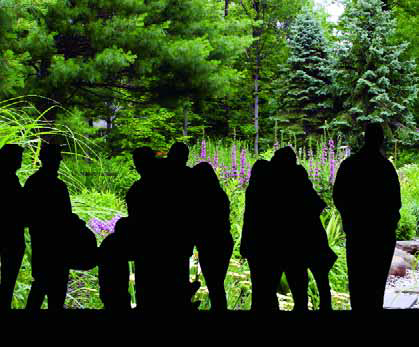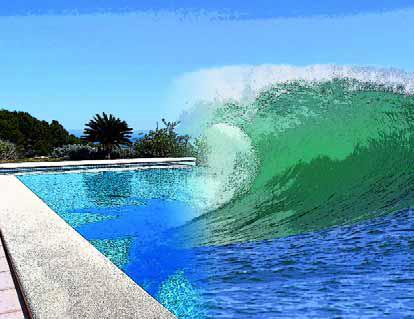inspiration
My love of nature started with a rock collection I had as a child: My fascination with the simple beauty of those small pieces of stone hit me early in life and never left. Several years later, my outlook was dramatically expanded when a wealthy uncle of mine paid to have a formal Japanese garden built for his home in Boulder, Colo. Ever since, I've had a profound appreciation of archetypal Japanese gardens and the way they celebrate nature through landforms, rocks, plants and water. By the time I was in high school, I had already decided that my career was going to involve working outdoors, and from that time forward, my prime interest was in bringing the techniques and disciplines of Japanese gardens into the greater American landscape both where I grew up in the Pacific Northwest and elsewhere. For 30 years now, I've worked as a landscape artist in that region - for 15 years in Portland and for the last 15 in Eugene, Ore. Although many of my designs are not what you could describe as "Japanese gardens" per se, everything I do is informed and influenced by those traditions. I bear no grudge of any sort against the beauty of gardens in the Western European tradition, but to my mind, there's nothing in landscape design that harmonizes more seamlessly with nature than
My love of nature started with a rock collection I had as a child: My fascination with the simple beauty of those small pieces of stone hit me early in life and never left. Several years later, my outlook was dramatically expanded when a wealthy uncle of mine paid to have a formal Japanese garden built for his home in Boulder, Colo. Ever since, I've had a profound appreciation of archetypal Japanese gardens and the way they celebrate nature through landforms, rocks, plants and water. By the time I was in high school, I had already decided that my career was going to involve working outdoors, and from that time forward, my prime interest was in bringing the techniques and disciplines of Japanese gardens into the greater American landscape both where I grew up in the Pacific Northwest and elsewhere. For 30 years now, I've worked as a landscape artist in that region - for 15 years in Portland and for the last 15 in Eugene, Ore. Although many of my designs are not what you could describe as "Japanese gardens" per se, everything I do is informed and influenced by those traditions. I bear no grudge of any sort against the beauty of gardens in the Western European tradition, but to my mind, there's nothing in landscape design that harmonizes more seamlessly with nature than
To me, designing and building ponds and streams is the best job in the world: It offers the professional rare opportunities to shape beautiful compositions that mimic nature and bring joy to those who spend time near the water's edge. It's hard work both physically and mentally, but ultimately, it's profoundly satisfying. I backed into this business while doing lawn and landscape maintenance work during high school. What I observed on that end of the market was a level of competition so intense that I soon recognized I'd need a specialty if I were to have any chance of pursuing a good career at it. In surveying the market, I noted that a number of landscaping firms were getting into naturalistic waterfeatures - and that the outcomes frequently looked terrible, even from my novice's perspective. To get in and out quickly, too many of these operators created systems that bore no resemblance to nature at all: From the rockwork to the way streams cut through spaces, what I saw just didn't square with what I'd seen in the real world. These shortcomings spelled opportunity, of course, but I also knew that to stand apart from the rest, I'd need to develop my own skills and deliver work that reached a much higher level than just about
To me, designing and building ponds and streams is the best job in the world: It offers the professional rare opportunities to shape beautiful compositions that mimic nature and bring joy to those who spend time near the water's edge. It's hard work both physically and mentally, but ultimately, it's profoundly satisfying. I backed into this business while doing lawn and landscape maintenance work during high school. What I observed on that end of the market was a level of competition so intense that I soon recognized I'd need a specialty if I were to have any chance of pursuing a good career at it. In surveying the market, I noted that a number of landscaping firms were getting into naturalistic waterfeatures - and that the outcomes frequently looked terrible, even from my novice's perspective. To get in and out quickly, too many of these operators created systems that bore no resemblance to nature at all: From the rockwork to the way streams cut through spaces, what I saw just didn't square with what I'd seen in the real world. These shortcomings spelled opportunity, of course, but I also knew that to stand apart from the rest, I'd need to develop my own skills and deliver work that reached a much higher level than just about
With spring upon us, calendars of local events are filling up with garden tours of all shapes and sizes. From large estate tours and special events at botanical gardens to tours of wonderful neighborhoods staged by local garden clubs, there's much to be seen while wandering through the grounds and yards and viewing the work of other designers and architects. I've always enjoyed these tours and learn something from each and every one, whether it's about a new plant or plant combination or an installation technique shared by a generous designer or installer who's on hand for that purpose. On a completely business note, I also have to say that some of my best-ever
With spring upon us, calendars of local events are filling up with garden tours of all shapes and sizes. From large estate tours and special events at botanical gardens to tours of wonderful neighborhoods staged by local garden clubs, there's much to be seen while wandering through the grounds and yards and viewing the work of other designers and architects. I've always enjoyed these tours and learn something from each and every one, whether it's about a new plant or plant combination or an installation technique shared by a generous designer or installer who's on hand for that purpose. On a completely business note, I also have to say that some of my best-ever
As the list of columns and articles appearing on these pages has grown longer and longer through the years, it has often been my pleasant duty to use my own column to call attention to
As the list of columns and articles appearing on these pages has grown longer and longer through the years, it has often been my pleasant duty to use my own column to call attention to
As designers, we learn to evaluate landscapes and watershapes with critical eyes, deciding if we like a plant palette, for example, or if a hardscape makes sense or a watershape is sited properly in a yard. These critical skills are important, because clients hire us to pull all of those elements together and develop solutions that suit their needs as well as those of the setting. On rare occasions, a design/build project will stay on a straight course from initial concept to execution. Usually, however, I know that any ideas or biases I carry onto a job site will change and become more complex as I get to know my clients' wants, needs and desires. In other words, my critical skill - my designer's point of view - is consistently
If you've been paying any attention to the media lately, you may have noticed that watershaping is "in" as a big-time topic for television, books, magazines, newspapers and other forms of mass communication. Never in all my years as part of this industry can I recall a time during which the subject of beautiful custom pools, spas, fountains, ponds, streams and interactive bodies of water has won so much attention. It seems as if our society has finally caught on to the power, beauty and excitement of the art form many of us



















